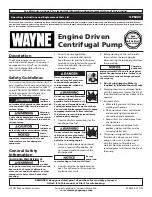
SECTION 2
THE UNITEC™ PUMP — HOW IT WORKS
The Wilden UNITEC™ pump is an air-operated, positive displacement, self-priming pump. These drawings show the flow pattern through
the pump upon its initial stroke. It is assumed the pump has no fluid in it prior to its initial stroke.
FIGURE 1: The air valve directs pressurized air to
the back side of diaphragm A. The compressed air
is applied directly to the liquid column separated by
elastomeric diaphragms. The diaphragm acts as a
separation membrane between the compressed air
and liquid, balancing the load and removing
mechanical stress from the diaphragm. The
compressed air moves the diaphragm away from
the center block of the pump. The opposite
diaphragm is pulled in by the shaft connected to the
pressurized diaphragm. Diaphragm B is on its
suction stroke; air behind the diaphragm has been
forced out to the atmosphere through the exhaust
port of the pump. The movement of diaphragm B
toward the center block of the pump creates a
vacuum within chamber B. Atmospheric pressure
forces fluid into the inlet manifold forcing the inlet
valve ball off its seat. Liquid is free to move past the
inlet valve ball and fill the liquid chamber (see
shaded area).
FIGURE 2: When the pressurized diaphragm,
diaphragm A, reaches the limit of its discharge
stroke, the air valve redirects pressurized air to the
back side of diaphragm B. The pressurized air
forces diaphragm B away from the center block
while pulling diaphragm A to the center block.
Diaphragm B is now on its discharge stroke.
Diaphragm B forces the inlet valve ball onto its seat
due to the hydraulic forces developed in the liquid
chamber and manifold of the pump. These same
hydraulic forces lift the discharge valve ball off its
seat, while the opposite discharge valve ball is
forced onto its seat, forcing fluid to flow through the
pump discharge. The movement of diaphragm A
toward the center block of the pump creates a
vacuum within liquid chamber A. Atmospheric pres-
sure forces fluid into the inlet manifold of the pump.
The inlet valve ball is forced off its seat allowing the
fluid being pumped to fill the liquid chamber.
FIGURE 3: At completion of the stroke, the air valve
again redirects air to the back side of diaphragm A,
which starts diaphragm B on its exhaust stroke. As
the pump reaches its original starting point, each
diaphragm has gone through one exhaust and one
discharge stroke. This constitutes one complete
pumping cycle. The pump may take several cycles
to completely prime depending on the conditions of
the application.
THE UNI-FLO™ AIR SYSTEM –
HOW IT WORKS
The Uni-Flo™ air distribution system, the driving force
behind UNITEC™ pumps, is assembled inside the center
section of the pump, between the reciprocating
diaphragms. The Uni-Flo™ systems uses a main air valve
body and mechanically actuated pilot spool mechanism
to direct inlet air pressure alternately behind each
diaphragm while at the same time exhausting the air
behind the opposite diaphragm to atmosphere. Air inlet
pressure has a direct relation to the fluid discharge pres-
sure that the pump can develop (head), while the volume
of air has a direct relation to how quickly the pump will
reciprocate (flow).
The pilot spool is pushed alternately left and right through
contact with the inside of the diaphragm as it moves
toward the center section on its exhaust stroke. The move-
ment of the pilot spool from one side to the other changes
the inlet and exhaust porting to each diaphragm by revers-
ing the air flow behind each diaphragm. The diaphragm
that pushed the pilot spool to shift the pump while on its
exhaust stroke is now pressurized with inlet air pressure
and pushed away from the center section displacing fluid.
This inherently safe design needs no electronic sensors or
switches to operate reliably while delivering product.
Speed and flow can be controlled with simple adjustments
to the air regulator, air inlet valve or fluid system valves.
The Uni-Flo™ system operates solely on compressed air
and is simple to use, specify and operate.
2
WILDEN PUMP & ENGINEERING, LLC
RIGHT STROKE
LEFT STROKE
MID STROKE
SIDE B
SIDE A
SIDE B
SIDE A
SIDE B
SIDE A
CLOSED
CLOSED
OPEN
CLOSED
OPEN
OPEN
CLOSED
OPEN
CLOSED
OPEN
CLOSED
OPEN




































